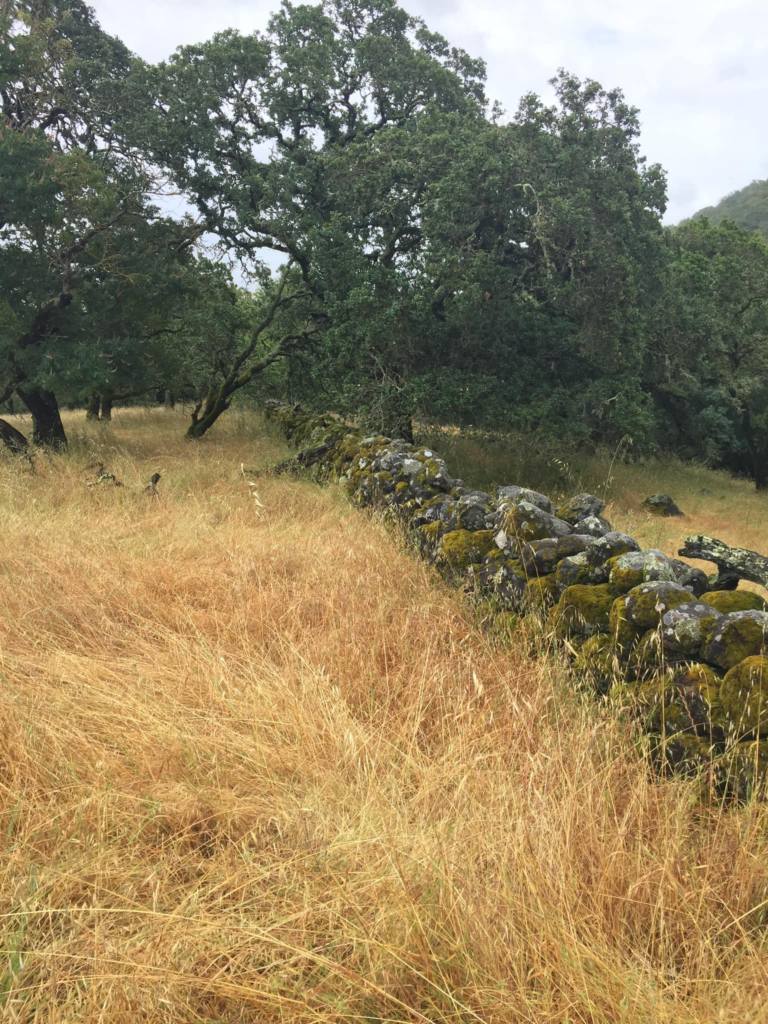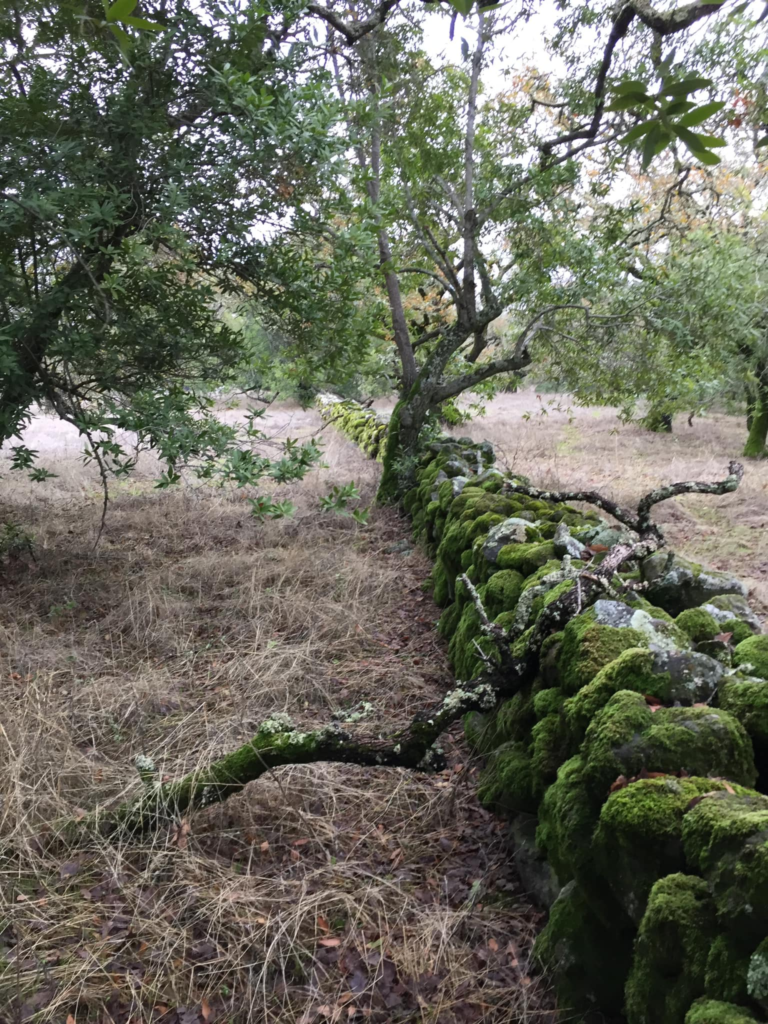Alameda to Santa Clara, Mound Builder Walls

Desert Sun, Number 127, 31 December 1984
Ancient stone wall baffles amateur historian
An ancient stone wall, which stretches for miles “like a demented snake,” may have been built by a lost civilization, according to an amateur historian who has devoted a year to unlocking the secret of the mysterious stones.
The stones have baffled residents for years. “Who built the prehistoric walls topping the Berkeley Hills? Do the miles of mysterious stone barriers…bespeak a lost civilization of Toltecs or Atlanteans?” wrote a San Francisco Chronicle reporter in 1904.
“These walls are just enigmas,” agreed Robert F. Fisher, former president of the Mission Peak Heritage Foundation. “They predate the Indians. They predate the Spaniards. It doesn’t fit in with any of the later history.”
But contemporary researchers have paid little attention to the old stone walls, Swanson said. The mostly forgotten wall is built of large basalt boulders, fitted closely together, and fragments are found from Berkeley to Milpitas. Strung together, the twisted stone enigma would probably be 20 miles long, said Russell Swanson, who has been studying the ruins.
“It’s like the Great Wall of China, except it’s one of those crazy things nobody can explain. Nobody knows how it got there,” said Swanson. “I’ve been bird-dogging this thing for years.”
Swanson, who is to present his findings this week to the Berkeley Historical Society, believes the walls were built by “pre-Columbian voyagers,” possibly from Japan or China, using Indian slave labor, but no historical records confirm this theory, said Swanson, who has devoted the past year to combing through old documents and taking aerial photographs of the site.
“A lot (of the wall fragments) start nowhere and end nowhere. There are stone circles on top of hills that appear to be solstice sites… This thing meanders like a demented snake,” he said.
“I don’t know of anyone who’s come up with a credible explanation. There isn’t any academic work on it,” said Charles Wollenbert, a Peralta Colleges historian.
“I must admit I’ve never seen those walls. That just shows you how us pointy-headed intellectuals are. We never go look at anything,” said James Deetz, a UC-Berkeley anthropology professor.
The Desert Sun article from 1984 sheds light on an enigmatic stone wall that has confounded residents and historians alike. The wall, made of large basalt boulders, stretches for miles and has fragments scattered across the area from Berkeley to Milpitas. Despite its mysterious origins, the wall has received little attention from contemporary researchers.
Russell Swanson, an amateur historian, has dedicated a year to unlocking the secret of the wall. He believes it may have been built by a lost civilization, possibly from Japan or China, and that it predates the Indians and the Spaniards. Swanson has combed through old documents and taken aerial photographs of the site to try and uncover its origins. He has found that some of the wall fragments start and end nowhere and that there are stone circles on top of hills that appear to be solstice sites.
Despite Swanson’s findings, there is no academic work on the wall, and historians remain baffled by its origins. While some suggest that European settlers or Spanish missionaries using Indian slave labor may have built the walls, there is no historical evidence to support this theory.
The wall is a fascinating mystery that has yet to be solved. It represents an important part of our history that is still waiting to be uncovered. With the ongoing development of new research techniques and technologies, it is possible that one day we will finally unlock the secrets of this ancient wall and discover the civilization that built it.
While there are various theories about the origins of the ancient stone wall found in the Berkeley Hills, one interpretation suggests that it may have been constructed by the Mound-Builders, a group of tall humans who lived in the area before Native Americans. This theory is based on the discovery of several mounds in the vicinity and the reported height of these Mound-Builders, ranging from 6’4″ to 8 feet tall. However, this theory is just one among many, and there is no concrete evidence to support it. The mystery of the ancient stone wall continues to intrigue researchers and enthusiasts, and hopefully, further study and investigation will shed more light on its origins and purpose.

Desert Sun, Number 127, 31 December 1984
Ancient stone wall baffles amateur historian
BERKELEY (AP) – An ancient stone wall, which stretches for miles “like a demented snake,” may have been built by a lost civilization, according to an amateur historian who has devoted a year to unlocking the secret of the mysterious stones.
The stones have baffled residents for years.
“Who built the prehistoric walls topping the Berkeley Hills? Do the miles of mysterious stone barriers… bespeak a lost civilization of Toltecs or Atlanteans?” wrote a San Francisco Chronicle reporter in 1904.
“These walls are just enigmas,” agreed Robert F. Fisher, former president of the Mission Peak Heritage Foundation. “They predate the Indians. They predate the Spaniards. It doesn’t fit in with any of the later history.”
But contemporary researchers have paid little attention to the old stone walls, Swanson said.
The mostly forgotten wall is built of large basalt boulders, fitted closely together, and fragments are found from Berkeley to Milpitas. Strung together, the twisted stone enigma would probably be 20 miles long, said Russell Swanson, who has been studying the ruins.
“It’s like the Great Wall of China, except it’s one of those crazy things nobody can explain. Nobody knows how it got there,” said Swanson. “I’ve been bird-dogging this thing for years.”
Swanson, who is to present his findings this week to the Berkeley Historical Society, believes the walls were built by “pre-Columbian voyagers,” possibly from Japan or China.
European settlers or Spanish missionaries, using Indian slave labor, may have built the walls, but no historical records confirm either theory, said Swanson, who has devoted the past year to combing through old documents and taking aerial photographs of the site.
“A lot (of the wall fragments) start nowhere and end nowhere. There are stone circles on top of hills that appear to be solstice sites… This thing meanders like a demented snake,” he said.
“I don’t know of anyone who’s come up with a credible explanation. There isn’t any academic work on it,” said Charles Wollenbert, a Peralta Colleges historian.
“I must admit I’ve never seen those walls. That just shows you how us pointy-headed intellectuals are. We never go look at anything,” said James Deetz, a UC-Berkeley anthropology professor.”
The mysterious stone wall found in Berkeley, California is a fascinating and perplexing archaeological puzzle that has confounded researchers for over a century. Despite being prehistoric and pre-dating both Native American and Spanish settlements in the area, little attention has been given to the wall by contemporary scholars. The lack of a credible explanation for the wall’s origin and purpose only adds to its intrigue, making it a subject of ongoing fascination for both amateur historians and academics alike.

